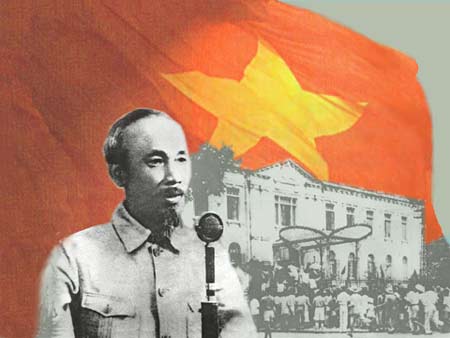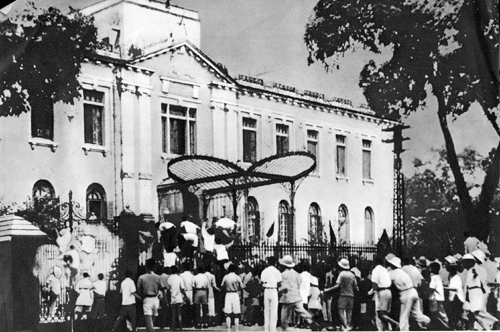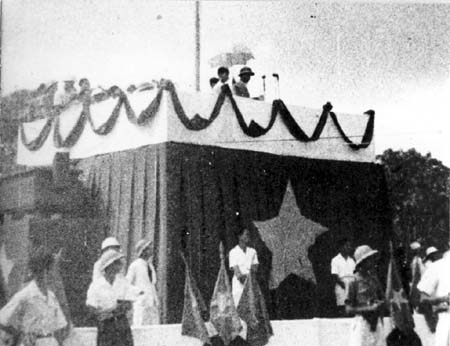
1. The issue of democracy in the Vietnamese Revolution during the period 1930-1945
The fundamental problem of every social revolution is to destroy the old government apparatus, overthrow the old ruling class, establish a new state, ruled by the new class, to build a new, more progressive social regime.
The bourgeois revolution is a revolution led by the bourgeoisie, with the goal and mission of destroying the feudal monarchy, establishing a bourgeois democratic state, ruled by the bourgeoisie to build a capitalist regime. That is a normal bourgeois revolution.
The bourgeois democratic revolution (new-style bourgeois revolution) or the national liberation revolution along the path of the proletarian revolution is a people's national democratic revolution led by the proletariat, a continuous revolution with a "dual" purpose: to save the country and save the people. That revolution has the task of both fighting imperialism and gaining independence for the nation and fighting feudalism, abolishing the feudalism-led feudalism, establishing a people's democratic regime led by the working class to advance towards socialism.
Nguyen Ai Quoc's purpose when going abroad in 1911 was tofind a way to save the country and save the peopleThat is, finding a way to satisfy two goals: both liberating the nation from foreign domination and saving the people from oppression and exploitation. Nguyen Ai Quoc surveyed many major revolutions in the world, such as the American Revolution and the French Revolution, and believed that those revolutions "not there yet", because after that the people were still oppressed and exploited, "wanted to make another revolution". He believed that only the Russian revolution led by VI Lenin and the Bolshevik Party was a true revolution, a revolution "arrive" because then "give power to the many, not to the few", meaning the revolution that brought the workers and peasants of Russia to power.
With such awareness and to carry out the "dual" purpose: saving the country associated with saving the people, Nguyen Ai Quoc decided to launch a national liberation struggle following the path of proletarian revolution like the Russian revolution and he did everything to propagate, awaken the nation, and guide the national and democratic movements of our country to follow the path of proletarian revolution led by the Communist Party.
InBrief outlineandBrief strategyof the Communist Party of Vietnam adopted at the Party's founding conference (February 1930) and inPolitical platformof the Party (October 1930), the Party advocated "overthrowing French imperialism and feudalism", "establishing a worker-peasant-soldier government", "carrying out bourgeois democratic revolution and land revolution to advance towards a communist society" ([2]).
Struggle for national liberation (in the narrow sense)There is no social revolution without a change in the ruling class., that was just an uprising against foreign invaders, like Lam Son uprising (15th century), Tay Son uprising (18th century). The struggle for national liberation with the aim of both gaining national independence and changing the ruling class from feudal landlords to the ruling class of the working class, of the working people, is called a social revolution.For that reason, Vietnam's national liberation struggle under the leadership of the Communist Party is considered a national liberation revolution (social revolution).
Revolution is creative. In the process of leading the revolution, the Party has always maintained its set goals, striving to carry out the people's national democratic revolution to advance towards socialism, with extremely flexible and creative solutions and directions.
Through the revolutionary climax of 1930-1931, with the peak being the Nghe-Tinh Soviet which suffered great losses (1932-1935), the Party sought to restore the movement and when conditions were favorable, immediately adjusted and changed the direction of the Vietnamese revolution, temporarily shelving the slogans of national independence and land for the tillers, launching a vibrant democratic movement (1936-1939), bringing the Vietnamese revolution forward. Although it did not directly fight to implement the slogans of national independence and land for the tillers, the democratic movement of 1936-1939 still belonged to the strategy of the people's national democratic revolution. The new form of state chosen by the Party to replace the worker-peasant-soldier state was the democratic republic (Indochinese Democratic Republic).
Since the end of 1939, due to the outbreak of World War II and its strong impact on Indochina, the Party has gradually moved the revolution to a new period, raising the goal of national liberation, preparing conditions to take power into the hands of the people, and establishing a democratic republic. In the resolution of the Party Central Committee meeting in May 1941 in Pac Bo, Cao Bang, there was a passage: "The current Indochina revolution is not a bourgeois democratic revolution, the revolution must solve two problems: anti-imperialism and land, but is a revolution that only solves one urgent problem "national liberation", so "the Indochina revolution in the current period is a national liberation revolution" ([3]).
Resolutely upholding the goal and task of national liberation, but to avoid cadres and party members from misunderstanding the relationship between strategic goals and urgent goals, between long-term tasks and current tasks of the bourgeois democratic revolution, the Resolution noted: "Saying that does not mean that our Party has abolished the problem of class struggle in the Indochina revolution. No! The problem of class struggle still exists forever"([4]). That "It is not that the Indochinese proletariat has abandoned its land-farming mission, nor has it taken a step back, but only taken a shorter step to have the strength to take a longer step"([5]).
That is, the Conference advocated changing the slogan of the struggle to achieve the immediate goal in the new situation, which was to advocate winning step by step towards winning complete victory for the people's national democratic revolution. The goal of "Land to the tillers" was not something that was not done, but was still partly done, which was "Confiscating land from the imperialists and traitors and distributing it to the tillers".
The point to note is that the issue of democracy is not only the issue of land, and it is not to be identified with the issue of land. The issue of democracy is much broader, deeper and more long-term than the issue of land, such as freedom to vote and run for office, freedom of speech, freedom of association, freedom of movement, freedom of demonstration, freedom of belief, gender equality, etc., that is, issues of human rights, civil rights, which are all things that are opposed to the absolute monarchy. Accordingly, temporarily put aside part of the slogan "The farmer has the field"It is not necessarily not to pursue democratic goals or to give up the democratic revolution.
Thus, it can be understood that the content of the Resolution of the 8th Central Conference (May 1941) did not contradict the previous strategic line of the Party and Nguyen Ai Quoc, but was only a policy of "before the eyes", for the stage "Present”, “not abolish class struggle”, not giving up the goal of democracy, but just “take a short step to gain strength to take a longer step”. That change fundamentally does not change the nature of the revolutionary ideals of the Party and Ho Chi Minh, but only changes the methods and steps in the “"currently", "before the eyes".The strategic goal and task is still to carry out the people's national democratic revolution, overthrow imperialism and feudalism, take power into the hands of the people, and build a democratic republic.
2. Democracy - The fundamental and unique value of the August Revolution
The truth is concrete. When the news of Japan's defeat by the Allies and the Japanese army in Indochina being paralyzed, the Tran Trong Kim government was extremely confused. With initiative and wisdom, the Party and Ho Chi Minh immediately organizedNational Conference of Party Cadres and National Congressin Tan Trao (Tuyen Quang). The conferences decided to launch a general uprising to seize power throughout the country with the principle of "concentration, unity, and timeliness". Following the policy of the Party and the Viet Minh Front, our entire nation rose up to gain independence and power. On August 19, 1945, the uprising was victorious in Hanoi, on August 23, it was victorious in Hue, and on August 25, it was victorious in Saigon. On August 30, King Bao Dai abdicated, officially ending the monarchy in Vietnam. On September 2, 1945, the National Day was held in the capital Hanoi.Government of the Democratic Republic of Vietnamnational introduction, democratic republic political system was established.
The reality of the August Revolution of 1945 has shown that it not only won national independence for Vietnam but also abolished the monarchy and established the democratic republic of Vietnam. The Declaration of the August Revolution was the Declaration of Independence, but the re-established political regime wasdemocratic republic, people's democracy, not a monarchy as at the end of previous uprisings against foreign invaders in Vietnamese history.

Demonstrators on August 19, 1945 in front of the Northern Palace, Hanoi.
Emphasizing the policy of promoting the goal of national liberation of the Party and Ho Chi Minh in the period of 1939-1945, promoting the value of national independence of the August Revolution of 1945 is correct and undeniable. However, absolutizing it, not emphasizing and promoting the democratic value, the historical significance of the destruction of the Nguyen Dynasty monarchy, establishing the Democratic Republic of Vietnam is only clarifying and promoting part of the Party's line and part of the victory of the August Revolution, and not distinguishing the qualitative difference between the August Revolution of 1945 and other uprisings in Vietnamese history.
The overthrow of the feudal monarchy and the establishment of a democratic republic in the August 1945 general uprising was not a side issue, a secondary goal, or a "convenient move" but a strategic goal of the Vietnamese revolution that was clearly defined when Nguyen Ai Quoc decided to liberate the nation along the path of proletarian revolution and in the Party's revolutionary platforms in 1930 and in the Resolution of the 8th Central Party Conference in May 1941.
Moreover, the fundamental problem of every social revolution is the problem of state power. If the August 1945 General Uprising had only driven out imperialism, like previous uprisings and resistance wars against foreign invaders in Vietnam's history, it would not have been a revolution. It is considered a revolution because it abolished the Nguyen Dynasty's feudal court and established the Democratic Republic of Vietnam, led by the working class through its political party, the Communist Party.
At Tan Trao, at the Party's National Conference (August 13, 1945) and the National Congress (August 16, 1945), the Party and Ho Chi Minh advocated establishing a provisional government calledVietnam National Liberation Committee, but when returning to Hanoi it was changed toGovernment of the Democratic Republic of Vietnam. InDeclaration of IndependenceReading at Ba Dinh Square on the afternoon of September 2, 1945, Ho Chi Minh emphasized its two core issues: freedom and independence, by mentioning two immortal values in the two declarations:Declaration of Independenceof the American Revolution andDeclaration of Human Rightsof the French Revolution, the two manifestos spoke about two major issues: national independence and human rights, democracy, and freedom. That was the sharp, quick strategic adjustment of the Party and Ho Chi Minh that made the General Uprising change in quality, becoming a social revolution with its full meaning.

President Ho Chi Minh read the Declaration of Independence at Ba Dinh Square on September 2, 1945
Immediately after the National Day, the Party, the State and Ho Chi Minh immediately began to lead, direct and carry out a series of great and urgent tasks to build a democratic republic of Vietnam. Such as completely abolishing the old government apparatus; organizing universal and democratic elections to elect the National Assembly and People's Councils at all levels; promulgating the People's Democratic Constitution; launching a movement to relieve hunger, eradicate illiteracy, and build a new life; pursuing a policy of friendly foreign relations with all countries in the world... The Party and Ho Chi Minh believed that the purpose of the national liberation revolution following the proletarian revolution was to both save the country and save the people, to resolutely gain independence to have freedom, to have freedom to have happiness.. People's happiness is the ultimate goal of the Vietnamese revolution.led by the Communist Party. Ho Chi Minh affirmed "Nothing is more precious than Independence and Freedom”.But he himself declared: "If the country is independent but the people do not enjoy happiness and freedom, then independence is meaningless"([6]).
National liberation and independence for Vietnam is a great task, a remarkable and great victory of the August Revolution. But after all, national liberation is something our people can do at any time. And overthrowing the monarchy, taking power into the hands of the people, establishing a democratic republic, bringing the working people from slavery to masters of the country, masters of society, withDemocratic Republic of Vietnam, the most progressive regime in Southeast Asia at that time, only the Communist Party and Ho Chi Minh, only the August Revolution of 1945b could do it.
That is the unique greatness of the August Revolution of 1945, the undeniable historical merit of the Communist Party and Ho Chi Minh. Accordingly, nation is a common, universal value and democracy is the fundamental, unique value of the August Revolution of 1945 when placed in the length of Vietnamese history and in the regional and world context at that time.
With such values, especially the unique democratic values, the August Revolution of 1945 in Vietnam, with the Declaration of Independence, establishing the Democratic Republic of Vietnam, proved that the Communist Party of Vietnam had made great contributions not only in the struggle for independence for the Vietnamese people but also in establishing a democratic republic for the Vietnamese people, that Ho Chi Minh was not only a national liberation hero but also an outstanding democrat, a great cultural celebrity of Vietnam and the world.
That also has the meaning of affirming that the achievement of the August 1945 general uprising was not only the victory of the national movement but also the result of the democratic movement, of the democratic revolution. It is also the affirmation that the Party and Ho Chi Minh not only raised the national flag but alsoraise high the flag of freedom and democracyduring the struggle for independence and during the August Revolution to seize power in 1945.
Honoring all the inherent values of the August Revolution of 1945, in the current revolutionary stage, it is necessary to especially emphasize the fundamental and unique values:humanism, human rights, humanity, democracy, strive to realize the noble ideal: building Vietnamindependence, freedom, happinessis the most correct perception, the most practical action of the historical significance of the 70th anniversary of the August Revolution and Vietnam's National Day (September 2, 1945 - September 2, 2015)./.
[1]- Associate Professor, Dr. Ngo Dang Tri - Faculty of History, University of Social Sciences and Humanities, VNUN.
[2]- Communist Party of Vietnam.Party documents, complete works,Volume 2 (1930), National Political Publishing House, Hanoi, 1998, page 2.
3. Communist Vietnam.Party documents, complete works, volume 7, 1940-1945, National Political Publishing House, Hanoi, p. 119.
[4]- Communist Party of Vietnam.Party documents,Complete Works, Vol. 7, ibid., p. 113.
[5]- Communist Party of Vietnam.Party documents, complete works, volume 7, Ibid, p. 119.
[6].Ho Chi Minh. Complete works, volume 4, 2000. National Political Publishing House, Hanoi, page 56.
Author:Associate Professor, Dr. Ngo Dang Tri
Newer news
Older news